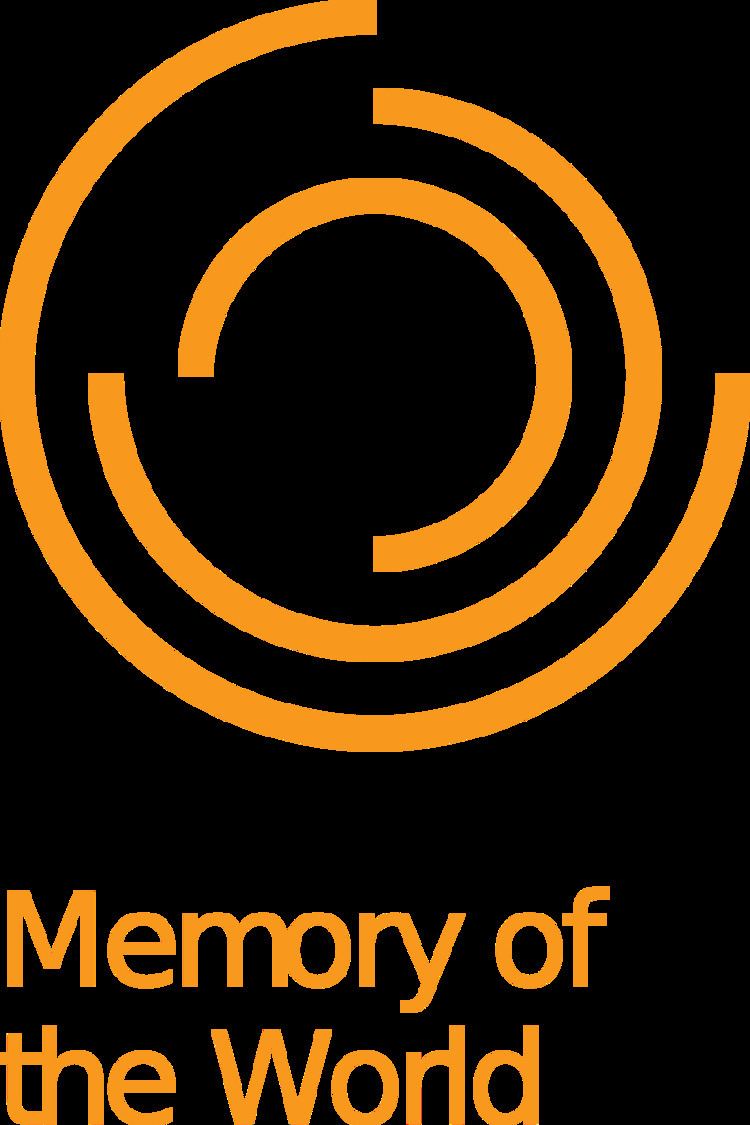 | ||
UNESCO's Memory of the World Programme is an international initiative launched to safeguard the documentary heritage of humanity against collective amnesia, neglect, the ravages of time and climatic conditions, and willful and deliberate destruction. It calls for the preservation of valuable archival holdings, library collections and private individual compendia all over the world for posterity, the reconstitution of dispersed or displaced documentary heritage, and the increased accessibility to and dissemination of these items.
Contents
Background and the IAC
In 1992, the program began as a way to preserve and promote documentary heritage, which can be a single document, a collection, a holding or an archival fonds that is deemed to be of such significance as to transcend the boundaries of time and culture. This recorded memory reflects the diversity of languages, people, and cultures. UNESCO, the world agency responsible for the protection of the world's cultural and natural heritage, realized the need to protect such fragile yet important component of cultural heritage. To this end, the Memory of the World Programme was established with the aim of preserving and digitizing humanity's documentary heritage.
The program is administered by the International Advisory Committee (IAC), whose 14 members are appointed by the UNESCO Director-General. The IAC is responsible for the formulation of major policies, including the technical, legal and financial framework for the program. Regular meetings were held by the IAC in its interim capacity beginning in 1993 to sustain the momentum gained by the program, culminating in the creation of the Memory of the World Register during its second meeting in 1995, with the inaugural batch of documents being inscribed on the Register in 1997, after the statutes that created the IAC as a standing committee took effect. The IAC also maintains several subsidiary bodies:
Memory of the World Register
The Memory of the World Register is a compendium of documents, manuscripts, oral traditions, audio-visual materials, library, and archival holdings of universal value. Inscription on the Register leads to improved conservation of the documentary heritage by calling upon the program's networks of experts to exchange information and raise resources for the preservation, digitization, and dissemination of the material. The program also has the goal of using state-of-the-art technologies to provide wider accessibility and diffusion of the items inscribed on the Register.
Any organization or individual can nominate a documentary item for inscription on the Register. During its meetings, the IAC examines the full documentation of the item's description, origin, world significance, and contemporary state of conservation. The body uses a set of criteria in examining each of the nominations:
- Time: Absolute age, of itself, does not make a document significant: but every document is a creature of its time. Some documents are especially evocative of their time, which may have been one of crisis, or significant social or cultural change. A document may represent new discovery or be the "first of its kind".
- Place: The place of its creation is a key attribute of its importance. It may contain crucial information about a locality important in world history and culture; or the location may itself have been an important influence on the events or phenomena represented by the document. It may be descriptive of physical environments, cities or institutions since vanished.
- People: The social and cultural context of its creation may reflect significant aspects of human behaviour, or of social, industrial, artistic or political development. It may capture the essence of great movements, transitions, advances or regression. It may reflect the impact of key individuals or groups.
- Subject and Theme: The subject matter may represent particular historical or intellectual developments in natural, social and human sciences, politics, ideology, sports and the arts.
- Form and Style: The item may have outstanding aesthetic, stylistic or linguistic value, be a typical or key exemplar of a type of presentation, custom or medium, or of a disappeared or disappearing carrier or format.
- Social/Spiritual/Community Significance: This concept is another way of expressing the significance of a document or set of documents in terms of its spiritual or sacred values. It allows a specific community to demonstrate its emotional attachment to the document or documents for the way in which these contribute to that community's identity and social cohesion. Application of this criterion must reflect living significance – the documentary heritage must have an emotional hold on people who are alive today. Once those who have revered the documentary heritage for its social/spiritual/community significance no longer do so, or are no longer living, it loses this specific significance and may eventually acquire historical significance.
Other matters that will also be taken into account for each nomination are:
As of 2015, the IAC has placed 348 documentary items of significance on the Register. Items are inscribed onto the Register during the IAC's biennial meetings, which take place every odd year:
Of the 301 documentary heritage items listed on the Register by 2013, 181, or more than half of the documents, is accounted for by the region encompassing Europe and North America, which includes 39 countries and/or territories.
In response to the worldwide scale of the Register, some countries or groups of countries have also established national (i.e. national registers) and regional counterparts, resulting in a three-tiered Register that has been supported by the Memory of the World Programme. This allows for the better administration of documentary items.
Jikji Prize
The Jikji Prize was established in 2004 in cooperation with the South Korean government to further promote the objectives of the Memory of the World Programme, and to commemorate the 2001 inscription of the country's Jikji on the Register. The award, which includes a cash prize of $30,000 from the Korean government, recognizes institutions that have contributed to the preservation and accessibility of documentary heritage.
The prize has been awarded biennially since 2005 during the meeting of the IAC.
